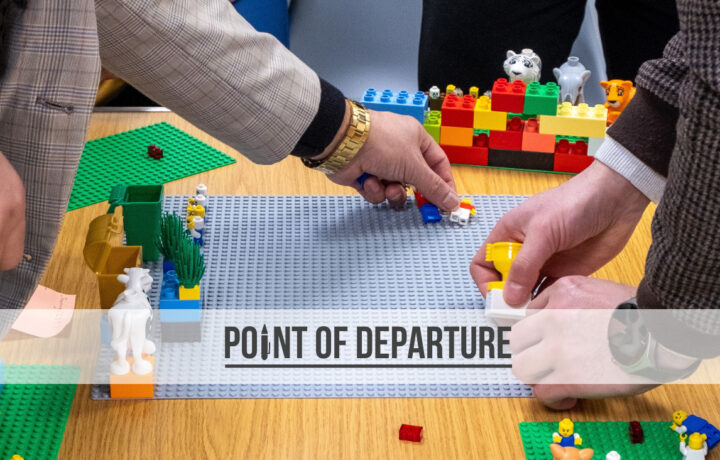“With a bucket of Lego, you can tell any story. You can build an airplane or a dragon or a pirate ship – it’s whatever you can imagine.” – Chrisopher Miller
I’m a brickophile.
As the son of an engineer, my childhood toys generally followed a construction theme: Lincoln Logs, Tinker Toys, the occasional Erector Set, and, of course, Lego. Most Saturday mornings, I could be found on the family room floor, surrounded by red and white bricks – they weren’t the bricks you see today – while cartoons played across the console television in the corner (back when you were lucky to get three channels). There, I would spend hours building something – anything – while my creative mind churned. Of all the memories of my childhood, that one is the clearest.
My children all grew up with a similar experience, although the cartoons had evolved along with the creativity of the sets. The X-Men and Johnny Bravo supplanted The Banana Splits and Fat Albert, and the sets… well, they were amazing, ranging from the traditional bucket of bricks to incredible themed sets and models. And we had them all.
And we still do. Although the kids are all grown, Lego is still a significant part of our lives, a shared experience across generations that connects us as a family. Lego is a common birthday gift, and when the entire family gathers for the holidays, we each take turns building on one of the massive sets while everyone else eats, opens gifts, or just savors the moment.
The Brick Pivot
Most people think of Lego and make the near-instantaneous connection to the little plastic bricks that we grew up with as children, were fascinated with through our youth, and stepped on a lot as adults. Lego – the name is a contraction of the Danish phrase leg godt, which translates to “play well” – was founded in 1932 by Ole Kirk Christiansen, a carpenter whose furniture and household goods business had suffered through the early years of the Great Depression. Christiansen put his remarkable woodworking talents to use as a toymaker, creating handmade trucks, animals, and even trains.
Following a fire in the wood shop, Christiansen was considering his options when he observed a demonstration of a plastic injection mold machine in Copenhagen. In early 1947, he purchased a British Windsor SH triple-injection molding machine, a significant investment that committed as much as half of the company’s earnings from the previous year. It was more than an investment – it was a major business risk. The machine wouldn’t be delivered for another year – not unusual in post-war Europe – and Christiansen spent the next year experimenting with ideas while creating plastic versions of his wooden toys.
Ten years later, Lego Group patented its iconic brick design and stopped making wooden toys altogether. The rest, as they say, is history.
The Paradoxes of Lego Leadership
Much of leadership comes down to setting the right culture. The literature on the subject is replete with both positive and negative examples. Setting a positive, productive culture isn’t all that difficult, but requires time, patience, and a fair amount of equally positive energy. On the other hand, driving a destructive culture requires little time, effort, or energy. In fact, their absence almost guarantees that the culture will take a turn for the worse.
Lego’s culture is cemented in it’s 11 Paradoxes of Leadership, a list described in the book, The Lego Story, that hangs in the offices of every member of the company’s management team. The list is a simple, yet effective, reminder of how to set a positive leadership culture.
1. To be able to establish close relationships with your employees – and to keep proper distance.
Boundaries. You want a close-knit team, but not so close that relationships cross a line.
2. To take the lead – and to recede into the background.
Empower them with responsibility and authority in their own right; but be there if and when they need you.
3. To show the employee confidence – and to be aware of their doings.
Leadership is not a fire-and-forget missile. If you trust someone enough to delegate a task to them, keep tabs on their progress.
4. To be tolerant – and to know how you want things done.
In a healthy work culture, people will bring different ideas to the table. Be open to those ideas. And don’t make the mistake of thinking that your way is the only way.
5. To be concerned about your own field of responsibility – and at the same time to be loyal to the overall goals of the company.
See the forest for the trees. There’s more than one path to the end goal, but don’t lose sight of that goal.
6. To plan your working-day carefully – and to be flexible to your planning.
Stuff happens. Have a plan but leave enough freedom of maneuver in that plan to allow for the unplanned.
7. To express your opinion – and to be diplomatic.
This is an important skill many of us struggle with. Facts, not emotions, win the argument.
8. To be visionary – and to keep both feet firmly on the ground.
Be an iconoclast; be creative, yet realistic.
9. To aim at consensus – and to be able to cut through.
It’s nice to get everyone on the same page, but it doesn’t always happen. Learn how to build consensus and power through to the end when you don’t gain it.
10. To be dynamic – but also thoughtful.
These two attributes are not on opposite ends of the leadership spectrum. Be sure that your character doesn’t come at a cost to those around you.
11. To be self-confident – and humble.
Humility is a powerful leadership trait. Be confident enough to embrace it.




